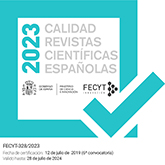The Musical Whistle as a Queer Space
DOI:
https://doi.org/10.3989/anuariomusical.2022.77.10Keywords:
Musical whistle, queer space, voice, identity construction, listen, body, sexuality, Molly Lewis, Laura Pergolizzi (LP)Abstract
This article argues for the use of the musical whistle as a queer space, as it problematizes the margins established for a gender classification based on timbre or tessitura as occurs with voice. To understand the peculiarity of the whistle in relation to the body that produces it, we propose two levels of listening. On the one hand, an acousmatic hearing of the whistle offers us misplaced possibilities in relation to the body and gender that are difficult to categorize in those margins. On the other hand, an audiovisual listening questions us about the possible paradoxes and corporeal-sonic contradictions that put into play sexist cultural discourses in relation to the musical whistle. We will use a theoretical framework based on queer studies to analyze concepts in relation to the voice —grain of the voice, the sonic body, the saphonic voice— and that may well be applicable to the study of the musical whistle around the construction of identity, and gender. The objective will be to understand how gender and sexuality interfere in the listening and production of music, even when the sound (timbre) with which the whistle is constructed offers possibilities of bodily and/or sexual escape; or, on the contrary, it can accentuate and problematize them by being incarnated visually.
Downloads
References
Auslander, Philip. «Musical Persona: The Physical Performance of Popular Music». En The Ashgate Research Companion to Popular Musicology, editado por Derek B. Scott. Abingdon y New York: Routledge, 2016, pp. 303-315.
Barthes, Roland. «The Grain of the Voice». En Image, Music, Text. Essays selected and translated by Stephen Heath. Londres: Fontana Press, 1977, pp. 179-189.
Born, Georgina. «Music and the materialization of identities». Journal of Material Culture, 16/4 (2011), pp. 376-388. https://doi.org/10.1177/1359183511424196
Cavarero, Adriana. «The Vocal Body. Extract from A Philosophical Encyclopedia of the Body». Qui parle, 21/1 (2012), pp. 71-83. https://doi.org/10.5250/quiparle.21.1.0071
Connor, Steven. Dumbstruck: A Cultural History of Ventriloquism. Oxford y New York: Oxford University Press, 2000. https://doi.org/10.1093/acprof:oso/9780198184331.001.0001
Cusick, Suzanne. «On a Lesbian Relationship with Music: A Serious Effort Not to Think Straight». En Queering the Pitch: The New Gay and Lesbian Musicology, 2ª ed., editado por Philip Brett, Elizabeth Wood y Gary C. Thomas. New York: Routledge, 2006, pp. 67-84.
DeNora, Tia. Music in Everyday Life. Cambridge: Cambridge University Press, 2000. https://doi.org/10.1017/CBO9780511489433
Eckhardt, Julia. Grounds for Possible Music: On Gender, Voice, Language, and Identity. Berlin: Errant Bodies Press, 2018.
Eidsheim, Nina Sun. Voice as a Technology of Selfhood: Towards an Analysis of Racialized Timbre and Vocal Performance. San Diego, CA: University of Califonia Press, 2008.
Frith, Simon. Performing Rites: On the Value of Popular Music. Cambridge, MA: Harvard University Press, 1996.
Halberstam, Jack. Masculinidad femenina. Traducción de Javier Sáez. Madrid-Barcelona: Editorial Egales, 2008.
Jarman-Ivens, Freiya. Queer Voices: Technologies, Vocalities, and the Musical Flaw. New York: PalGrave MacMillan, 2011. https://doi.org/10.1057/9780230119550
Kassabian, Anahid. «Music, Sound and the Moving Image: The Present and a Future?». En The Ashgate Research Companion to Popular Musicology, editado por Dereck B. Scott. Abingdon y New York: Routledge, 2009, pp. 43-57.
Koestenbaum, Wayne. The Queen's Throat: Opera, Homosexuality and the Mystery of Desire. New York: Poseidon Press, 1993.
Kristeva, Julia. Revolution in Poetic Language. Traducción de Margaret Waller. New York: Columbia University Press, 1984.
Lucas, John, y Allan Chatburn. A Brief History of Whistling. Nottingham: Five Leaves, 2013.
«Molly Lewis: the almost-forgotten art of musical whistling», Radio New Zealand (RNZ), 17 de julio de 2021. <https://www.rnz.co.nz/national/programmes/saturday/audio/2018804367/molly-lewis-thealmost-forgotten-art-of-musical-whistling>.
Müller, L. J. Sound und Sexismus. Geschlecht im Klang populärer Musik. Eine feministisch-musiktheoretische Annäherung. Hamburg: Marta Press, 2018.
Mulvey, Laura. Placer visual y cine narrativo. Valencia: Universidad de Valencia, Centro de Semiótica y Teoría del Espectáculo, 1998.
Peraino, Judith A. Listening to the Sirens: Musical Technologies of Queer Identity from Homer to Hedwig. Berkeley: University of California Press, 2005. https://doi.org/10.1525/california/9780520215870.001.0001
Schwartz, Hillel. «Whistling for the Hell of It». En The Routledge Companion to Sounding Art, editado por Marcel Cobussen, Vincent Meelberg y Barry Truax. Abingdon y New York: Routledge, 2017, pp. 341-50.
The Whistling Podcast. "Exploring the world of musical whistling». <http://thewhistlingpodcast.com> [consulta: 9/08/2022].
Wallon, Simone. «Une "Chanson à siffler" au temps de Louis XIV». Revue de Musicologie, 54/1 (1968), pp. 102-105. https://doi.org/10.2307/927410
Wicke, Peter. «Das Sonische in der Musik». En Pop- Scriptum, 10: Das Sonische. Sounds zwischen Akustik und Ästhetik, ed. Jens Gerrit Papenbug. Berlin: Humboldt- Universität zu Berlin, 2006.
Wood, Elizabeth. «Sapphonics». En Queering the Pitch: The New Gay and Lesbian Musicology. 2ª ed., editado por Philip Brett, Elizabeth Wood y Gary C. Thomas. Abingdon y New York: Routledge, 2006, pp. 27-66.
Woloshyn, Alexa. «Electroacoustic Voices: Sounds Queer, And Why It Matters». Tempo, 71/280 (2017), pp. 68-79. https://doi.org/10.1017/S0040298217000092
Downloads
Published
How to Cite
Issue
Section
License
Copyright (c) 2022 Consejo Superior de Investigaciones Científicas (CSIC)

This work is licensed under a Creative Commons Attribution 4.0 International License.
© CSIC. Manuscripts published in both the printed and online versions of this Journal are the property of Consejo Superior de Investigaciones Científicas, and quoting this source is a requirement for any partial or full reproduction.All contents of this electronic edition, except where otherwise noted, are distributed under a “Creative Commons Attribution 4.0 International” (CC BY 4.0) License. You may read here the basic information and the legal text of the license. The indication of the CC BY 4.0 License must be expressly stated in this way when necessary.
Self-archiving in repositories, personal webpages or similar, of any version other than the published by the Editor, is not allowed.















